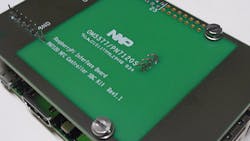Near-field communication (NFC) is a wireless technology that can be found in most of the new smartphones. The list is rather long. It can be found in Apple’s latest iPhone 6S as well as the iPhone 6 to drive its Apple Pay service (see “Will Apple Boost NFC?” on electronicdesign.com). It is also in Samsung’s Galaxy S5 and S6. NFC readers have been cropping up in stores as credit-card kiosks are updated. These typically handle credit-card swipes, smartcards, and NFC.
Most of the major NFC players have been working on this technology for a while now, but smartphones and payment kiosks are not the only items to take advantage of NFC (see “NFC/RFID Ripe for Application Expansion” on electronicdesign.com). Now with NXP’s OM5577 Interface Board kit, developers can pair NXP’s NFC support with popular development platforms like the Raspberry Pi 2 (Fig. 1) and the BeagleBone. The kit comes with an NXP PN7120 NFC controller module that plugs into either a Raspberry Pi (Model B, B+ or 2) or BeagleBone (original or Black) expansion socket.
The kit can be used to interface with any NFC device, including NFC-enabled smartphones. The PN7210 supports the NFC Forum device requirements V1.3 compliant for all modes. It actually has its own ARM Cortex-M0 in the chip. This includes support for NFC Forum Type 1/2/3/4/5 tags. The NFC chips uses an I²C host interface and it can handle read/write, peer-to-peer, and card-emulation mode. The module has an integrated antenna.
Getting the system up and running is relatively easy since the two platforms, Raspberry Pi 2 or BeagleBone, run Linux. Just be careful plugging in the PN7210 module. The sockets are a bit tight and I tend to be a little fumble-fingered sometimes (Fig. 2). Luckily you will probably only use one of the adapters, so the module will be installed just once.
The kit comes with demos and drivers for Linux and Android. I used the Raspberry Pi 2 running the Raspbien operating system. Most of the demo apps provide a text interface that is accessible via the command line shown on the HDMI driven display. I checked out the supplied demos, including ones that displayed NFC info and another for writing tag data. They also worked nicely using an SSH connection as well.
The demo source is easy enough to modify to create some interesting NFC-enabled applications, including something like an NFC-enabled television or at least a close facsimile.
Most of the heavy lifting is hidden behind the NFC chip and drivers. The advantage is that the communication is secure. NFC also has advantages over Bluetooth since pairing is not required. In fact, Bluetooth pairing is an application for NFC.


